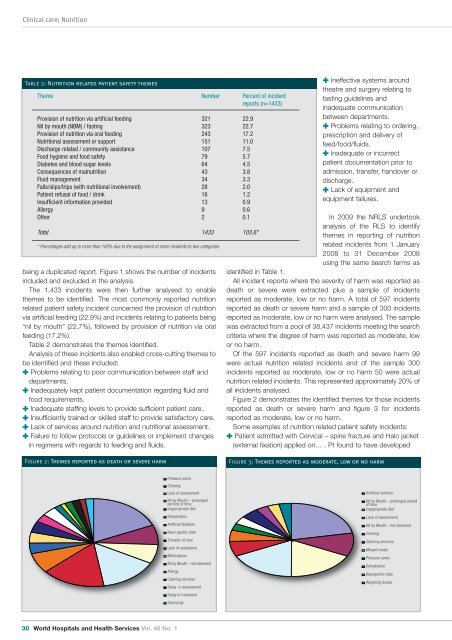vol46.1 LR.pdf - International Hospital Federation
vol46.1 LR.pdf - International Hospital Federation
vol46.1 LR.pdf - International Hospital Federation
You also want an ePaper? Increase the reach of your titles
YUMPU automatically turns print PDFs into web optimized ePapers that Google loves.
Clinical care: Nutrition<br />
Table 2: Nutrition related patient safety themes<br />
Theme Number Percent of incident<br />
reports (n=1433)<br />
Provision of nutrition via artificial feeding 321 22.9<br />
Nil by mouth (NBM) / fasting 323 22.7<br />
Provision of nutrition via oral feeding 243 17.2<br />
Nutritional assessment or support 151 11.0<br />
Discharge related / community assistance 107 7.5<br />
Food hygiene and food safety 79 5.7<br />
Diabetes and blood sugar levels 64 4.5<br />
Consequences of malnutrition 43 3.8<br />
Fluid management 34 3.3<br />
Falls/slips/trips (with nutritional involvement) 28 2.0<br />
Patient refusal of food / drink 16 1.2<br />
Insufficient information provided 13 0.9<br />
Allergy 9 0.6<br />
Other 2 0.1<br />
Total 1433 103.6*<br />
* Percentages add up to more than 100% due to the assignment of some incidents to two categories.<br />
being a duplicated report. Figure 1 shows the number of incidents<br />
included and excluded in the analysis.<br />
The 1,433 incidents were then further analysed to enable<br />
themes to be identified. The most commonly reported nutrition<br />
related patient safety incident concerned the provision of nutrition<br />
via artificial feeding (22.9%) and incidents relating to patients being<br />
“nil by mouth” (22.7%), followed by provision of nutrition via oral<br />
feeding (17.2%).<br />
Table 2 demonstrates the themes identified.<br />
Analysis of these incidents also enabled cross-cutting themes to<br />
be identified and these included:<br />
✚ Problems relating to poor communication between staff and<br />
departments.<br />
✚ Inadequately kept patient documentation regarding fluid and<br />
food requirements.<br />
✚ Inadequate staffing levels to provide sufficient patient care.<br />
✚ Insufficiently trained or skilled staff to provide satisfactory care.<br />
✚ Lack of services around nutrition and nutritional assessment.<br />
✚ Failure to follow protocols or guidelines or implement changes<br />
in regimens with regards to feeding and fluids.<br />
✚ Ineffective systems around<br />
theatre and surgery relating to<br />
fasting guidelines and<br />
inadequate communication<br />
between departments.<br />
✚ Problems relating to ordering,<br />
prescription and delivery of<br />
feed/food/fluids.<br />
✚ Inadequate or incorrect<br />
patient documentation prior to<br />
admission, transfer, handover or<br />
discharge.<br />
✚ Lack of equipment and<br />
equipment failures.<br />
In 2009 the NRLS undertook<br />
analysis of the RLS to identify<br />
themes in reporting of nutrition<br />
related incidents from 1 January<br />
2008 to 31 December 2008<br />
using the same search terms as<br />
identified in Table 1.<br />
All incident reports where the severity of harm was reported as<br />
death or severe were extracted plus a sample of incidents<br />
reported as moderate, low or no harm. A total of 597 incidents<br />
reported as death or severe harm and a sample of 300 incidents<br />
reported as moderate, low or no harm were analysed. The sample<br />
was extracted from a pool of 38,437 incidents meeting the search<br />
criteria where the degree of harm was reported as moderate, low<br />
or no harm.<br />
Of the 597 incidents reported as death and severe harm 99<br />
were actual nutrition related incidents and of the sample 300<br />
incidents reported as moderate, low or no harm 50 were actual<br />
nutrition related incidents. This represented approximately 20% of<br />
all incidents analysed.<br />
Figure 2 demonstrates the identified themes for those incidents<br />
reported as death or severe harm and figure 3 for incidents<br />
reported as moderate, low or no harm.<br />
Some examples of nutrition related patient safety incidents:<br />
✚ Patient admitted with Cervical – spine fracture and Halo jacket<br />
(external fixation) applied on… . Pt found to have developed<br />
Figure 2: Themes reported as death or severe harm<br />
Figure 3: Themes reported as moderate, low or no harm<br />
Pressure sores<br />
Choking<br />
Lack of assessment<br />
Nil by Mouth – prolonged<br />
periods of time<br />
Inappropriate diet<br />
Dehydration<br />
Artificial Nutrition<br />
Naso-gastric tube<br />
Transfer of care<br />
Lack of assistance<br />
Medications<br />
Nil by Mouth – not observed<br />
Allergy<br />
Catering services<br />
Delay in assessment<br />
Delay in treatment<br />
Discharge<br />
Artificial nutrition<br />
Nil by Mouth – prolonged period<br />
of time<br />
Inappropriate diet<br />
Lack of assessment<br />
Nil by Mouth – not observed<br />
Choking<br />
Catering services<br />
Missed meals<br />
Pressure sores<br />
Dehydration<br />
Nasogastric tube<br />
Weighing Scales<br />
30 World <strong>Hospital</strong>s and Health Services Vol. 46 No. 1

















